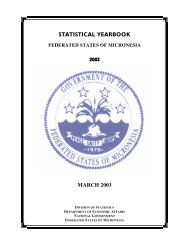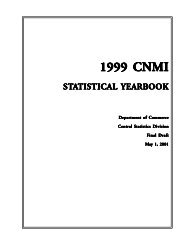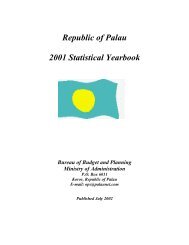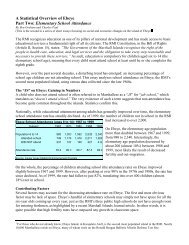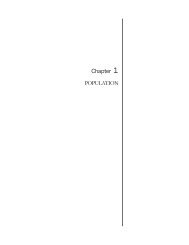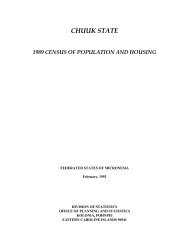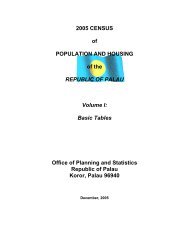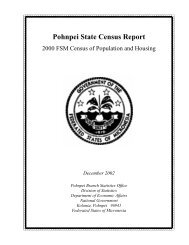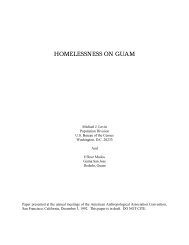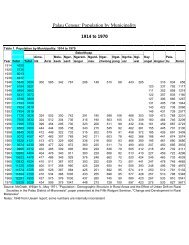Chuuk State Census Report - pacificweb.org
Chuuk State Census Report - pacificweb.org
Chuuk State Census Report - pacificweb.org
Create successful ePaper yourself
Turn your PDF publications into a flip-book with our unique Google optimized e-Paper software.
CHAPTER 9ECONOMIC ACTIVITYIntroductionThe changing economy of <strong>Chuuk</strong> <strong>State</strong> creates a demand for data on labor force characteristics and job activities. Thefollowing chapters provide insight into the adjustments <strong>Chuuk</strong> <strong>State</strong> is making as it moves from subsistence to a cashorientedeconomy. Information on economic activity, industries and occupations, and income is presented in the nextthree chapters.In <strong>Chuuk</strong> <strong>State</strong> the potential labor force, defined as the population of working age (15 years and above), accountedfor 29,068 persons (55 percent) of the population during the 1994 <strong>Census</strong>, and 31,587 persons (44 percent) duringthe 2000 <strong>Census</strong>. Many potential contributors to <strong>Chuuk</strong> <strong>State</strong> production were not in the labor force because theywere students, house workers looking after children, or retired. Two in every five of the working age populationwas currently working, or seeking work in the government, the private sector, or the subsistence or traditionalsectors (involving mainly agriculture and fishing).DefinitionsIn order to determine the current labor force status, all respondents aged 15 years and over were asked whether theydid any 'work' in the week before the census, including full-time or part-time work. Work also included full-timeand part-time work in a family farm or business, with or without pay. Work did not include unpaid volunteer work.The series of questions on employment status was designed to identify several types of individuals in <strong>Chuuk</strong> <strong>State</strong>:persons who worked at a job or business or farm at any time during the reference week; persons who did not do suchwork during the reference week, but who had jobs or businesses from which they were temporarily absent; andpersons who did not work during the reference week, but who were looking for work during the reference week.The labor force included the employed work force as well as the unemployed.The total employed labor force was made up of a number of constituent groups, including persons who worked fullorpart-time at a job or business, and persons who worked mainly in farming or fishing during the reference weekregardless of whether any of their produce was sold or not. The latter group has been classified in agriculture andfishing and further sub-classified as market-oriented and subsistence.A person was described as a subsistence worker if he/she mainly farmed or fished in the week before the censuswithout selling, or intending to sell, any produce. Persons who did only some subsistence, but mainly worked atanother job in the week before the census were not included in this group. Persons who farmed or fished and soldtheir produce were also in the agricultural/fishing group but were categorized as market oriented.Unemployed persons were those persons who were looking and available for work in the four weeks preceding thecensus.The economically inactive working age population, those not in the labor force, were working age persons notclassified as being employed or unemployed. A special group of inactive persons were those who were notemployed nor looking for work but who said they could have taken a job if one had been offered to them. Thesepersons were categorized as "could have taken a job".Labor force participation rates (LFPR) were calculated by dividing the number of persons in the labor force by thepotential labor force of the group. For example a LFPR for women aged 15 to 19 would be calculated by dividingthe number of women both employed and unemployed by the total number of women aged 15 to 19 and multipliedby 100 to make it a percentage.Unemployment rates, on the other hand, were calculated by dividing the number of persons unemployed by thenumber of persons in the labor force, and again multiplied by 100 to make it a percentage.<strong>Chuuk</strong> Branch Statistics Office, Division of Statistics, FSM Department of Economic Affairs 75



